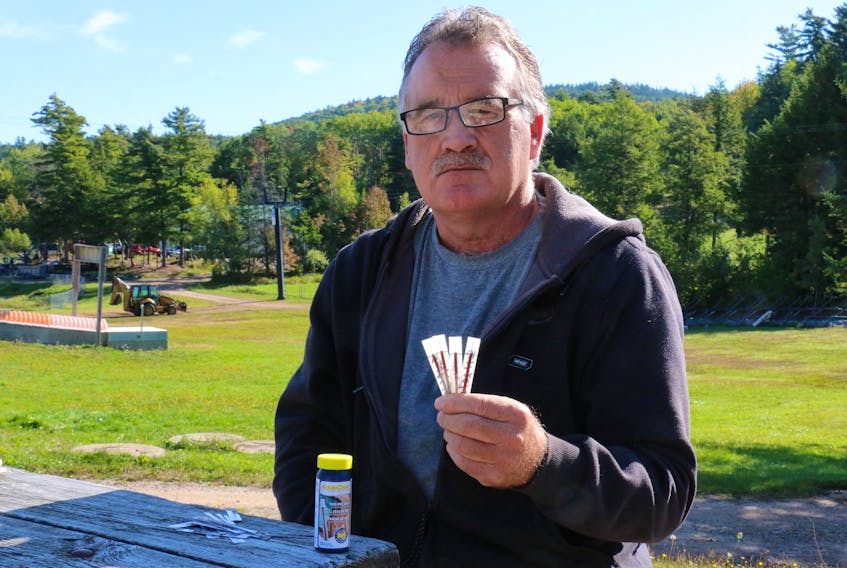WINDSOR FORKS, N.S. — Every morning since late August, Jim Boylan goes to the intake site of Ski Martock’s main freshwater supply, dips a test strip into the Avon River, and tests its water quality.
He started this morning ritual after a neighbour discovered the salinity levels upstream from Lake Pisiquid were climbing.
“The first day I went out there after I heard there was salt, I did taste it,” Boylan said.
“It was salty. You couldn’t drink that. You had to spit it back out.”
While salty water is a health and environmental concern, it also isn’t conducive for making quality snow like Ski Martock is known for.
Jim and Heather Boylan are the owners of Ski Martock, and since 1980, have been drawing water from the Avon River.
To say they’re concerned with this new development is an understatement.

The intake location, which is about three kilometres away, houses two vertical turbine pumps. Those pumps transport freshwater, at 2,000 gallons per minute, underground to a holding pond at Ski Martock. A combination of water and compressed air is then piped up the hill to make snow.
Last year, they used 56 million gallons of water — roughly enough to fill 85 Olympic-sized swimming pools.
If the freshwater supply ceases, the Boylans are worried about the future.
“(We’re) very concerned. That’s where we draw water for our snowmaking. Right now, there’s no alternative water source that we know of,” Heather Boylan said.
“It will pretty well shut us down,” Jim Boylan said.

The Avon River causeway is at the heart of the issue. The manmade structure opened in 1970 and restricted the tidal flow, creating a freshwater head-pond that is known as Lake Pisiquid. With a failing aboiteau system and the need for a twinned Highway 101, the Province of Nova Scotia is now looking to address the controversial structure.
A variety of groups are involved with lobbying the government. Some want to see the causeway removed and the river allowed to return to a free tidal flow. Others are urging the government to keep some form of causeway to preserve Lake Pisiquid and freshwater up stream.
The Boylans are on the side of keeping the freshwater.
“We’re not against fish passage. We want fish passage, but we also want to operate a ski resort with consistent freshwater,” said Heather Boylan.
The Boylans say finding an alternative freshwater source isn’t an easy task. The two that are nearby are not suitable. Mill Lake serves as the former town of Windsor’s main water supply, while Panuke Lake, another freshwater body of water, is used for generating power in Hantsport.

Jim Boylan said he doesn’t think people realize the impact using saltwater to make snow would have on operations.
“It’s all the different things that will happen if we pump that water up the hill if it contains salt — the corrosion to our pipes, the damage to our pumps, the runoff causing havoc with the farmers below us,” said Boylan, shaking his head.
There is no doubt that saltwater will affect the snowmaking process, he said.
“The saltwater will freeze but it lowers the temperature of the freezing point,” he said, noting the salt will drop out of the water at the base of the snow guns.
In the springtime, the water that’s used to make snow at Ski Martock melts and runs down to a brook, which leads back to the river.
If the runoff is contaminated with a high concentration of salt, that runoff will be like “a salt brine” as it makes its way back to the river, he said.
“It would be a higher concentration of salt, which will probably kill everything in its path from here back to the river,” he said.
This would impact several Falmouth and Windsor Forks farmers.
He also questions what will happen to the groundwater supply should that salty runoff occur.

SALINITY LEVELS TOO HIGH
Ski Martock’s owners brought a sample they took on Sept. 1 to Envirosphere Consultants Ltd. in Windsor for testing.
The water sample, drawn from the intake area of the Avon River that Ski Martock uses for snowmaking, failed the Canadian Drinking Water Quality Guidelines for sodium and chloride levels.
The chemical analysis provided showed a sodium level of 1,570 milligrams per litre and a chloride level of 2,830 milligrams per litre. Both levels would provide “an unacceptable taste to the water.”
In terms of sodium, “individuals on a medically-supervised sodium-restricted diet should limit their intake of water that exceeds 20 mg/L of sodium.”
As for chloride, the normal range in drinking water is five to 20 mg/L.
According to the analysis provided, “chloride also makes water more corrosive in the distribution system. Major sources are natural salt deposits, salt water intrusion, road salt and contamination from septic tank systems.”
Jim Boylan has been keeping track of the surface level salinity by using AquaChek pool and spa test strips that measure the salt content.
The readings were consistently high from Aug. 28 until mid-September. After post-tropical storm Teddy pounded the province with wind and rain Sept. 22-23, Boylan said the salt content in his samples was nearly non-existent.
The water went from a high reading of 5,010 parts per million to under 300 ppm.
“I’ve just been sampling off the surface. The farther you go down in depth, the more salt there is in the water. Saltwater is more dense so it hugs the bottom of the river,” he said.
Prior to this year, the Boylans hadn’t tested the water so they can’t compare the results to prior years.

ECONOMIC IMPACT
The crew at Ski Martock starts the snowmaking process near the end of November, beginning of December. They aim to have the snow in place by the end of January.
It takes roughly 600 hours to make enough snow for the multiple trails for alpine skiers and snowboarders.
“We can see power bills of $95,000 per month when we’re making snow,” Jim Boylan said.
Andy MacLean, the operations manager at Ski Martock, has been with the organization for 36 years.
When it comes to the water that’s taken from the Avon River for the hill’s snowmaking operations, he said they “just store it for a few months every year on the hill and then it goes back.”
MacLean said shutting down the recreational resort would be devastating for a variety of reasons, chief among them the economic and health benefits the hill provides.
“There are 200 employees that rely on this seasonally and 12 full-time year-round,” said MacLean, noting most of them are local.
They welcome between 80,000 and 100,000 guests per season, and around 10,000 school kids as part of an outdoor recreation program.
According to a letter provided to West Hants council, Heather Boylan said “Martock is the community field of play for Alpine Ski Nova Scotia’s and Nova Scotia Snowboard’s grassroots, development and elite athlete programming along with local club programming, which includes the Nova Scotia School Athletic Federation, Martock Ski Race and Martock Snowboard Team.”
Ski Martock has produced three Olympians — Trevor Andrew, Sara Conrad, and Alex Duckworth — and there’s no shortage of up-and-coming pro athletes training at the site each year.
“It provides a pretty amazing outlet for people to be outside and active and it’s been built up around that freshwater (source). It’s grown and existed because of it,” said MacLean.
The Boylans have invested in multiple course and equipment upgrades at the hill over the decades. They currently have two mobile HKD turbo fan guns (costing about $35,000 a piece), 95 fixed tower guns on the hill and 95 sled guns that can be used in different places on the hill.
Also located on site is Beavertails and Cleve’s Source For Sports, businesses that employ an additional 10-15 people.
“This is our livelihood,” said Jim Boylan.
In order to raise awareness of the concerns of Hants County farmers and businesses that rely on the freshwater, Avon River Freshwater Stakeholders has organized a Sunday parade. Ski Martock will be among the participants.
The parade, scheduled to start at noon Sept. 27, will feature tractors, trucks, wagons and cars. The parade route starts at the Hants County Exhibition grounds, proceeds along Wentworth Road to O’Brien Street, to Gerrish Street, along Water Street and across the bridge to Falmouth.










